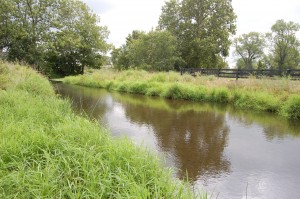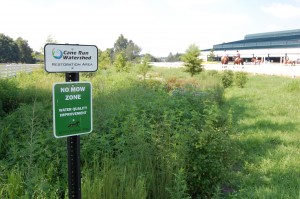Friday at Castlewood Park
By Will Rush
On Friday, August 12, the typically tranquil Castlewood Park will be alive with the festivities of the second annual Cane Run Watershed Festival. The event, hosted by the Cane Run Watershed Council, will raise awareness of the problems facing the watershed and help teach the community how to protect their delicate waterways.
Although most people are familiar with the term “watershed,” many do not fully understand what a watershed is. All water, whether it comes from the sky, a sprinkler, or your toilet, must go somewhere, and a watershed is the area of land that drains into a single stream, river, lake, or other body of water. The Mississippi River watershed, for example, is roughly 1.2 million square miles and is made up of countless smaller watersheds, including the Cane Run.
The southern end of the 29,000 acres that comprise the Cane Run Watershed starts on the north side of Lexington and extends all the way to Georgetown. Driving down New Circle Road, it’s hard to believe that you are traveling alongside an endangered ecosystem, for the path of flowing water has been heavily manipulated by the urbanization of the area. Most of the ground in this area is impermeable, and during heavy rains, the high volume of runoff forms channels that make their way out of city limits.
As you follow Cane Run Creek, you begin to notice more distinct signs of life as the creek makes its way through quiet neighborhoods and on through Lexmark’s Shadybrook Park. In these areas the Cane Run Watershed Council has made a lot of progress in protecting the waterway by planting black willows and other plants and creating stream-side buffer zones that help prevent erosion and allow the stream to recover its natural meander.
Further along, Cane Run flows through the University of Kentucky’s Agricultural Experiment Farm, where the council has teamed up with the university to create no mow zones and fenced stream crossings for horses to minimize the damage to the banks. By this point, much of the water has disappeared underground into the karst limestone, making the tangible benefits of good stream management difficult to appreciate, except in times of heavy rainfall.
A little further downstream, the Cane Run Watershed continues through the Kentucky Horse Park. In preparation for the FEI World Equestrian Games, the council helped restore a small stream in the heart of the park, planting native trees, shrubs, and perennials – a truly beautiful scene that is currently teeming with flowers.
As the water seeps into the ground, it helps fill the Royal Spring Aquifer – and during a wet enough season, it continues above ground to the north fork of Elkhorn Creek. Here the benefits of protecting the watershed become clear, as the Elkhorn is one of the many tributaries of the Kentucky River, and the Royal Spring Aquifer is a main source of Georgetown’s drinking water.
Among the main problems that face the watershed are high amounts of sediments, pathogens, and nutrients. While Cane Run has been classified as an impaired stream, the culprits are not easily identified. The majority of the damage is caused by “non-point source pollution,” meaning it comes from a variety of small sources. Simple littering in north Lexington and other high traffic areas like I-64 is one source. During heavy rains, Lexington’s sanitary sewer can overflow into the storm sewer and contaminate the watershed. High erosion rates on poorly managed stream-sides also cause sediment increases that wreak havoc on the delicate balance of the ecosystem.
Beyond teaming up with major landowners like the University of Kentucky and Kentucky Horse Park to promote better management of the watershed, there are a few direct actions to be taken to protect the watershed. Stream cleanup projects are common and always looking for volunteers. The main objective of the festival will be to raise northside residents’ awareness of about what they can do day-to-day to help keep the water clean. There will be workshops for eco-friendly auto and lawn care, recycling and litter reduction, and the use of rain barrels.
The Cane Run Watershed Festival is set to kick off at 5 P.M. on Friday, August 12 at Castlewood Park and will continue until 8 P.M. In addition to the workshops, there will be free food for the first 500 guests, children’s activities, and a raffle featuring the grand prize of a mulching mower. Art exhibits at the Lexington Art League (located in the Loudoun House) will also be open for festival goers. Proceeding rain or shine (it is a watershed festival after all), festival organizers expect to top last year’s turnout of 350 people and would love to see you support the protection of one of our most precious resources.
Attendees can register at http://canerun2011.eventbrite.com. The flora and fauna of Cane Run Watershed would like to thank the Cane Run Watershed Council, the UK College of Agriculture, the Lexington-Fayette Urban County Government, the United States Environmental Protection Agency, and Friends of Cane Run for their work. For more information visit www.canerunwatershed.org.






Leave a Reply